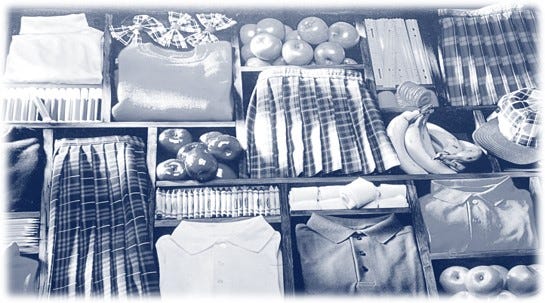Carensa Anderson on Creating Fashion with Purpose and End-of-Life Solutions
Sustainability Journey of a Fashion Product Developer
Hi everyone, I’m back! For the first issue of February 2025, it’s my pleasure to feature Carensa Anderson. An expert of sustainable product development, she has worked with UNLESS Collective, adidas, and Jones New York.
I’m always fascinated by the complex process of bringing a product to life, so Carensa’s experience feels very inspiring. From sourcing supplies, conceptualizing design, developing products, and taking care of the logistics of production, she has done it all. When we got connected last year, I immediately asked her to be part of Fafafoom Studio Newsletter during our intro chat.
Thankfully, she said yes. So here are the insights that Carensa so generously provides about sustainability in fashion. Enjoy!
Mira Musank (Mira): Let’s start from the beginning. Carensa, please introduce yourself and share how you got started in fashion.
Carensa Anderson (Carensa): Hello, I am Carensa Anderson! I am originally from India, studied art & design in London and lived in Europe for a bit before landing a job as a design assistant in NYC after school. The role was with a small women’s sportswear brand that had a foothold in the boutique business along the East Coast. Over a span of 2 years, I got to learn every facet of the business. To this day, I am still thankful to have that experience, a perk of working with a small company.
When it was time to move on, I got an opportunity to first join the PD (Product Development) team and then eventually the Material Team at Jones New York, which over a course of 10 years across 12 different labels, was the starting point of a larger discussion with myself about clothing for purpose, which led me to adidas.
“What’s better than to do this than at a big brand creating products for sport, health and fitness?” At least that was my rationale when I joined them. Still not quite satisfied that I was doing enough, my focus during my time at adidas turned to sustainability - such a buzz word and so broad of a term.
So when the opportunity to be part of a startup called UNLESS Collective, where a product was created with the end of life in mind; creating products (both apparel and footwear) that are able to biodegrade and safely be returned to planet earth was music to my ears.
As is the way with most startups, funding can be a challenge. So I made the jump to Dennis Uniform, where the dream was to really make a difference and create biodegradable pools for kids across the US. Unfortunately this 104-year-old legacy brand closed up shop at the end of last year so I am currently consulting for a couple of brands.
I loved art and design growing up, and being surrounded by beautiful fabrics of cottons, silks, brocades and embroideries, I think it was a natural progression into textiles and design which paved the way into fashion.
Mira: Your expertise is really incredible! You have mentioned working in material sourcing and product development roles with big brands like adidas and Jones New York, as well as the sustainable startup UNLESS Collective. Would you share how your roles evolved over the years?
Carensa: I would say evolution, as with most things, has come over time. My focus and roles over time shifted from just creating product to creating product for purpose and then to “the how” of creating sustainable product with the end of life purpose in mind (a term coined at UNLESS).
One thing that has remained consistent is the concept of “waste not, want not”, I grew up hearing and living it.
If one is purposeful in what they buy, then it is used to its maximum potential. And then the product is either repurposed or disposed of in the best possible way. The culture we live in now drives consumerism with no real solutions by brands on what should happen when the consumer is done with the product.
Mira: Exactly! As the term “sustainability” is getting more mainstream, we have seen projections of many meanings into that one word, causing it to arguably lose its original definition.
The go-to definition when discussing sustainability is “meeting the needs of the present without compromising the ability of future generations to meet their own needs”...
In 1987, the United Nations Brundtland Commission published the above definition of sustainability in the Brundtland report, which called for a strategy that united development and the environment. Over the years, alternative definitions have emerged, but the Brundtland report’s 1980s take on the explanation is still commonly used. [Source: Earth.org.]
adidas has a mission to provide the “best sports products in the world, and to offer the best service and consumer experience – and to do it all in a sustainable way.” (Source: Adidas Group.) On the other hand, Unless Collective provides no compromise in manifesting sustainability in their products, containing zero plastic materials.
As someone who worked in developing products for both brands, how do you experience, lead, or influence the understanding and execution of “sustainability” in your teams?
Carensa: Thank you for sharing the meaning of the term “sustainability” as defined by one of the UN Commission’s. I am in agreement with the pillars as defined by Earth.org, but how does one actually break it all down to lay person or consumer?
My perspective (and how I lead and influence) is that from a product standpoint there are two parts to sustainability. The first part is the materials, development/supply chain process, and vendors used to bring the product to life. So my question to the teams is, what sustainable materials and practices are being used and how can we showcase this? Most big brands do have sustainability goals and initiatives that all of this can tie into and the marketing content around it.
The second part is the real challenge and this is where the most solutions are needed: where does the product go once the consumer is done with it. Also equally important is the education around what are the consequences if a product is not disposed of in the most sustainable manner.
In an ideal world, brands build circular products and provide the necessary education around it. The consumer in turn, is accountable to follow the necessary steps when they are done with the product. All of this is easier said than done, because it needs to be a combined and collaborative effort of laws and policy change along with tax breaks/credits, initiatives, rebates etc to both the brands and consumers.
Mira: The fashion industry has been talking about challenges within the textile production lifecycle for decades, but why don’t we talk about existing or emerging solutions in the same fervor?
Carensa: This ties back into my previous answer, that it is going to take huge policy change in tandem with brand collaboration for any real solutions to be implemented.
I am glad to see that Gap has partnered with Ambercycle to try and build circularity solutions, hopefully in the synthetic space. UNLESS Collective is leading the way in the natural fiber/plastic free space.

Mira: Why is it difficult to manifest more people-friendly, planet-friendly solutions? Within the sustainable fashion space, there’s an extended discussion that people’s increasing awareness of overproduction and overconsumption doesn’t necessarily translate to mindset or behavior change. Brittany Sierra of The Sustainable Fashion Forum and Green Behavior Podcast has repeatedly driven down this point.
And that is the case of “the system is working as designed,” right? We are accustomed to chasing short-term instant gratification, poorly equipped to consider long-term benefits that don’t necessarily only benefit yourself, but others around you (neighbors, soil, pollinators, plants). What’s your take on that, Carensa?
Carensa: I am in complete agreement with Brittany and cannot emphasize enough that it is both a mindset and lifestyle change and an understanding how product consumerism directly correlates to our ecosystem.
Unfortunately for a lot of people, climate change is still a myth so that mindset needs to change first before any buying and lifestyle habits can be affected. Hopefully the more podcasts and documentaries there are, the more people know and start to make a change.
Mira: Last time we talked, you mentioned that when you joined the school uniform business project, a large scale project that you’d like to pursue if the opportunity arises: biodegradable Polos. Would you be willing to share more about this dream project of yours?
Carensa: When I moved on from UNLESS Collective to the Dennis Uniform, my dream was to build biodegradable polos for school kids across the country to wear. Imagine a place where the kids of today who have to take on the world’s problems of tomorrow can stand tall and proud and say they are doing their bit and being part of a bigger movement. That dream will have to wait since Dennis Uniform is no longer in business.
Mira: Works focused on climate and sustainability are going to be very challenging in these four years (or more). It takes everyone to make a meaningful change. What would be your advice to people who are passionate about climate work, yet feeling discouraged to face the enormous headwind ahead? And is there anything else you’d like to share?
Carensa: I think what happens in the next 4 years is probably going to impact many more years to come but in a reverse manner. I hope I am proven wrong. My advice to people who are passionate about climate work is to do their part in their community and ensure their voice is heard. To kick off this year, I joined my district Town Hall specifically for a voice for climate activism because I want to do more, not less.
Anyone who is passionate and would like to talk more about sustainability or climate activism can reach out to me through LinkedIn. It is definitely going to take a village and a movement to get us through the next 4 years.
And big THANK YOU to Mira for asking me to share my story!
-
Oh Carensa, I am grateful to you for sharing your story! Here’s to the undying passion to pursue sustainability in fashion.
Thanks for reading; until next time,
Mira Musank





